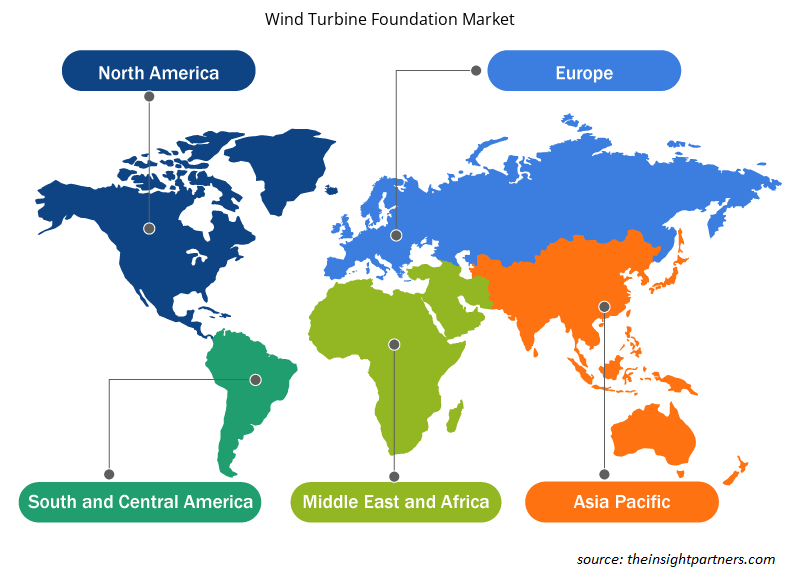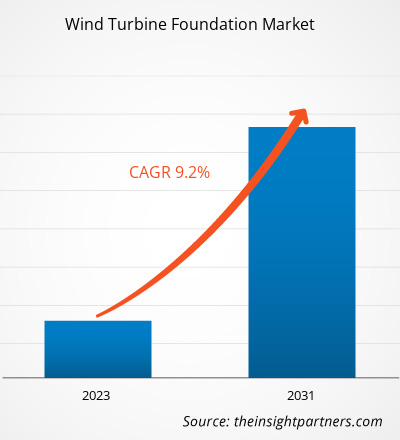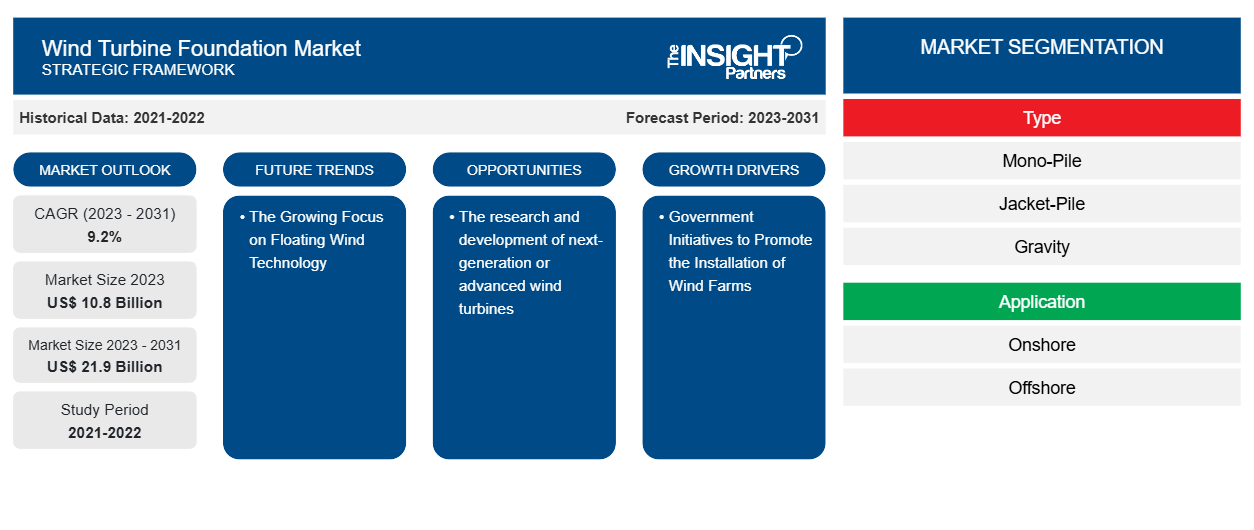Se prevé que el tamaño del mercado de cimientos de turbinas eólicas alcance los 21 900 millones de dólares en 2031, frente a los 10 800 millones de dólares en 2023. Se espera que el mercado registre una CAGR del 9,2 % durante el período 2023-2031. Es probable que la investigación y el desarrollo de turbinas eólicas avanzadas o de última generación sigan siendo tendencias clave en el mercado.
Análisis del mercado de cimientos para aerogeneradores
Se espera que el mercado de cimientos para turbinas eólicas experimente un crecimiento considerable durante el período analizado debido al creciente número de proyectos de energía eólica terrestre y marina, en particular en ubicaciones remotas. Además, se espera que las regulaciones gubernamentales para reducir las emisiones de carbono centrándose en la generación de energía a través de fuentes de energía renovables como la eólica, la solar, la geotérmica y otras impulsen el crecimiento del mercado entre 2023 y 2031. Además, se proyecta que las iniciativas gubernamentales para la instalación de parques eólicos en todo el mundo impulsarán el crecimiento del mercado en los próximos años.
Descripción general del mercado de cimientos para turbinas eólicas
Con el aumento de la población y la industrialización, la demanda de energía también está aumentando a nivel mundial. El aumento del consumo de energía también impulsó la necesidad de generación de energía renovable en las economías en desarrollo y desarrolladas. Esto ha dado lugar a un aumento de la demanda de infraestructura de energía eólica en todo el mundo. La generación de energía eólica ha ganado un alto nivel de importancia y aceptabilidad en todo el mundo en comparación con otras fuentes de energía renovable. Los avances tecnológicos en el diseño y desarrollo de palas, turbinas, cimientos, ejes y otros componentes de energía eólica han contribuido a un avance significativo en la adopción de la energía eólica y en la consecución de la máxima potencia del viento disponible. Según la Agencia Internacional de Energías Renovables (IRENA), la capacidad eólica instalada mundial alcanzó los 1.017 GW a finales de 2023, frente a los 825 GW de 2021.
Por lo tanto, se espera que en los próximos años se incremente la capacidad instalada de energía eólica, debido a las ventajas de la energía eólica y a las políticas favorables, los incentivos y las devoluciones fiscales. Se prevé que este aumento de la capacidad de instalación de energía eólica en todo el mundo sea el factor clave en el mercado de cimientos para turbinas eólicas.
Personalice este informe según sus necesidades
Obtendrá personalización en cualquier informe, sin cargo, incluidas partes de este informe o análisis a nivel de país, paquete de datos de Excel, así como también grandes ofertas y descuentos para empresas emergentes y universidades.
-
Obtenga las principales tendencias clave del mercado de este informe.Esta muestra GRATUITA incluirá análisis de datos, desde tendencias del mercado hasta estimaciones y pronósticos.
Factores impulsores y oportunidades del mercado de las fundaciones de turbinas eólicas
Iniciativas del Gobierno para impulsar la instalación de parques eólicos favorecerán el mercado
Se prevé que un aumento del apoyo de varios gobiernos de diferentes países en términos de políticas, subsidios e inversiones para aumentar la instalación de proyectos de energía eólica impulse el crecimiento del mercado de cimientos de turbinas eólicas durante el período analizado. El gobierno indio se dedica a promover las plantas de energía eólica en el país a través de la financiación del sector privado al proporcionar diversos incentivos fiscales y financieros, como beneficios de depreciación acelerada y exenciones de impuestos o derechos de aduana concesionales sobre ciertos componentes de los generadores de electricidad eólica . Por ejemplo, Alemania está planeando presentar un proyecto de ley para acelerar la expansión de la energía eólica. La nueva ley aplicará objetivos de área vinculantes para la expansión de la energía eólica terrestre en los estados federales. En abril de 2022, Alemania planeó implementar objetivos de energía eólica marina de más de 10 GW por año a partir de 2025 con la ayuda de un paquete histórico llamado Paquete de Pascua, que es la serie de cambios más profunda en la política energética alemana. Con la ayuda de estas iniciativas gubernamentales, el 80% de la demanda de electricidad de Alemania estará cubierta por electricidad de fuentes de energía renovables para 2030.
El creciente interés por la tecnología eólica flotante
La tecnología eólica flotante es la turbina eólica marina montada sobre una estructura flotante en el mar que garantiza que la turbina genere electricidad en las profundidades del agua. La tecnología eólica flotante o marina es altamente eficiente en condiciones ambientales adversas y, por lo tanto, capaz de producir enormes cantidades de energía. Esta tecnología eólica flotante se ha adoptado globalmente en varios países, como China, Alemania, Japón, el Reino Unido, Francia, Bélgica y Dinamarca. Las perspectivas de crecimiento en la adopción de la tecnología eólica flotante se atribuyen principalmente a un aumento en el avance de la tecnología, las ventajas asociadas y las soluciones llave en mano proporcionadas por varios proveedores de servicios. La creciente conciencia de la necesidad de lograr objetivos de energía limpia por parte de varios países está impulsando la demanda de energía eólica marina flotante, lo que plantea una oportunidad potencial para el crecimiento del mercado de cimientos de turbinas eólicas.
El informe del Centro de Excelencia de Energía Eólica Marina Flotante ha identificado a 22 países que están más preparados para convertirse en actores importantes en la naciente tecnología de energía renovable. En enero de 2022, el gobierno del Reino Unido anunció 11 proyectos de energía renovable que recibirán hasta 959,23 millones de dólares cada uno, al tiempo que propone 2.970 millones de dólares para impulsar la energía renovable generada en el Reino Unido. Se prevé que esta inversión en tecnología eólica marina o flotante en todo el mundo impulse el crecimiento del mercado en los próximos años.
Informe de mercado de cimientos de turbinas eólicas Análisis de segmentación
Los segmentos clave que contribuyeron a la derivación del análisis del mercado de cimientos de turbinas eólicas son el tipo y la aplicación.
- Según el tipo, el mercado de cimentaciones para aerogeneradores se divide en monopilote, pilote de cubierta, gravedad, trípode, succión, balsa, pilote, cimentación de pozo, roca y anclaje, entre otros. El segmento de gravedad tuvo una mayor participación de mercado en 2023.
- Según la aplicación, el mercado se segmenta en onshore y offshore. El segmento onshore tuvo una mayor participación de mercado en 2023.
Análisis de la cuota de mercado de los cimientos de las turbinas eólicas por geografía
El alcance geográfico del informe de mercado de cimientos de turbinas eólicas se divide principalmente en cinco regiones: América del Norte, Asia Pacífico, Europa, Medio Oriente y África, y América del Sur y Central.
Asia Pacífico dominó el mercado de cimientos para turbinas eólicas en 2023. La región de Asia Pacífico incluye China, Australia, India, Corea del Sur, Japón y el resto de Asia Pacífico. Asia Pacífico representó la mayor participación de mercado en el mercado mundial de cimientos para turbinas eólicas en 2023, y se espera que se expanda a la CAGR más rápida durante el período de pronóstico. La sólida industria terrestre y la presencia de una gran cantidad de fabricantes de cimientos para turbinas eólicas en toda el área son responsables de la alta participación de mercado. Además, el sector offshore en expansión en China, Japón, Corea del Sur y el sudeste asiático está impulsando el mercado de proveedores de cimientos para turbinas eólicas en toda la región. Además, se proyecta que un aumento en la inversión hacia la instalación de parques eólicos terrestres y marinos en la región impulsará la demanda de cimientos para turbinas eólicas en los próximos años.
Perspectivas regionales del mercado de cimientos de turbinas eólicas
Los analistas de Insight Partners explicaron en detalle las tendencias y los factores regionales que influyen en el mercado de cimientos de turbinas eólicas durante el período de pronóstico. Esta sección también analiza los segmentos y la geografía del mercado de cimientos de turbinas eólicas en América del Norte, Europa, Asia Pacífico, Oriente Medio y África, y América del Sur y Central.

- Obtenga datos regionales específicos para el mercado de cimientos de turbinas eólicas
Alcance del informe de mercado de cimientos de turbinas eólicas
| Atributo del informe | Detalles |
|---|---|
| Tamaño del mercado en 2023 | US$ 10.8 mil millones |
| Tamaño del mercado en 2031 | US$ 21.9 mil millones |
| CAGR global (2023 - 2031) | 9,2% |
| Datos históricos | 2021-2022 |
| Período de pronóstico | 2023-2031 |
| Segmentos cubiertos |
Por tipo
|
| Regiones y países cubiertos |
América del norte
|
| Líderes del mercado y perfiles de empresas clave |
|
Densidad de actores del mercado de cimientos de turbinas eólicas: comprensión de su impacto en la dinámica empresarial
El mercado de cimientos de turbinas eólicas está creciendo rápidamente, impulsado por la creciente demanda de los usuarios finales debido a factores como la evolución de las preferencias de los consumidores, los avances tecnológicos y una mayor conciencia de los beneficios del producto. A medida que aumenta la demanda, las empresas amplían sus ofertas, innovan para satisfacer las necesidades de los consumidores y aprovechan las tendencias emergentes, lo que impulsa aún más el crecimiento del mercado.
La densidad de actores del mercado se refiere a la distribución de las empresas o firmas que operan dentro de un mercado o industria en particular. Indica cuántos competidores (actores del mercado) están presentes en un espacio de mercado determinado en relación con su tamaño o valor total de mercado.
Las principales empresas que operan en el mercado de cimientos para aerogeneradores son:
- Fugro
- Grupo Ramboll A/S
- Iberdrola SA
- BW Ideol
- Grupo Peikko
- Grupo EEW
Descargo de responsabilidad : Las empresas enumeradas anteriormente no están clasificadas en ningún orden particular.

- Obtenga una descripción general de los principales actores clave del mercado de Wind Turbine Foundation
Noticias y desarrollos recientes del mercado de cimientos de turbinas eólicas
El mercado de cimientos para turbinas eólicas se evalúa mediante la recopilación de datos cualitativos y cuantitativos posteriores a la investigación primaria y secundaria, que incluye publicaciones corporativas importantes, datos de asociaciones y bases de datos. A continuación, se enumeran algunos de los avances en el mercado de cimientos para turbinas eólicas:
- Odfjell Oceanwind colaboró con Prodtex. Esta colaboración tenía como objetivo ampliar la capacidad de producción de cimientos eólicos flotantes con el objetivo de abrir la instalación en 2027. (Fuente: Odfjell Oceanwind, comunicado de prensa, febrero de 2024)
- Principle Power lanzó una nueva base eólica flotante con paneles planos y base de pontón denominada WindFloat F. Esta base está diseñada para la integración de turbinas eólicas de superficie ultra superficial en puertos (Fuente: Principle Power, comunicado de prensa, septiembre de 2023)
Informe de mercado sobre la base de turbinas eólicas: cobertura y resultados
El informe “Tamaño y pronóstico del mercado de cimientos de turbinas eólicas (2021-2031)” proporciona un análisis detallado del mercado que cubre las siguientes áreas:
- Tamaño del mercado de cimientos de turbinas eólicas y pronóstico a nivel mundial, regional y nacional para todos los segmentos clave del mercado cubiertos bajo el alcance
- Tendencias del mercado de cimientos de turbinas eólicas, así como dinámica del mercado, como impulsores, restricciones y oportunidades clave
- Análisis PEST y FODA detallados
- Análisis del mercado de cimientos de turbinas eólicas que abarca las tendencias clave del mercado, el marco global y regional, los principales actores, las regulaciones y los desarrollos recientes del mercado
- Análisis del panorama de la industria y de la competencia que abarca la concentración del mercado, el análisis de mapas de calor, los actores destacados y los desarrollos recientes del mercado de cimientos de turbinas eólicas
- Perfiles detallados de empresas
- Análisis histórico (2 años), año base, pronóstico (7 años) con CAGR
- Análisis PEST y FODA
- Tamaño del mercado, valor/volumen: global, regional y nacional
- Industria y panorama competitivo
- Conjunto de datos de Excel
Informes recientes
Informes relacionados
Testimonios
Razón para comprar
- Toma de decisiones informada
- Comprensión de la dinámica del mercado
- Análisis competitivo
- Información sobre clientes
- Pronósticos del mercado
- Mitigación de riesgos
- Planificación estratégica
- Justificación de la inversión
- Identificación de mercados emergentes
- Mejora de las estrategias de marketing
- Impulso de la eficiencia operativa
- Alineación con las tendencias regulatorias























 Obtenga una muestra gratuita para - Mercado de cimientos de aerogeneradores
Obtenga una muestra gratuita para - Mercado de cimientos de aerogeneradores